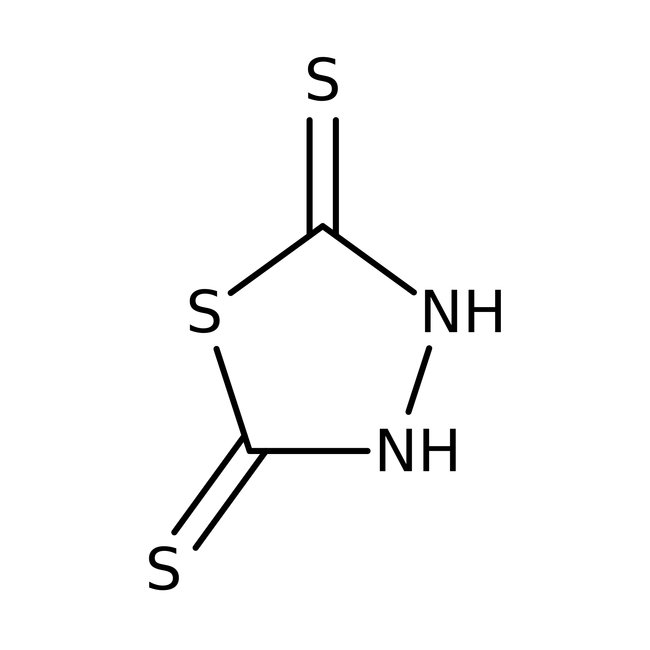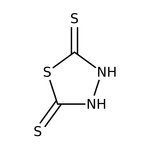Search Thermo Fisher Scientific
Thermo Scientific Chemicals
2,5-Dimercapto-1,3,4-thiadiazole, 97% (dry wt.), water <3%
CAS: 1072-71-5 | C2H2N2S3 | 150.23 g/mol
Catalog number ALFA12615.30
View Price:Sign InSign in to see your account pricing. Need an account? Register with us today.
Quantity:
250 g
Specifications
Chemical Name or Material2,5-Dimercapto-1,3,4-thiadiazole
CAS1072-71-5
Health Hazard 1H315-H319-H335
Health Hazard 2GHS H Statement
H315-H319-H335
Causes skin irritation.
Causes serious eye irritation.
May cause respiratory irritation.
H315-H319-H335
Causes skin irritation.
Causes serious eye irritation.
May cause respiratory irritation.
Health Hazard 3P261-P264b-P271-P280-P302+P352-P304+P340-P305+P351+P338-P312-P332+P313-P362-P501c
View more
2,5-Dimercapto-1,3,4-thiadiazole is used in synthesizing polymers and heavy metal and basic salts. It acts as an additive in lubricating oils, greases and in electrode compositions. It also acts as an intermediate for pharmaceuticals and dyes, as a chelating agent in the analysis of metals. It also serves as an anticorrosion and antirust agent.
This Thermo Scientific Chemicals brand product was originally part of the Alfa Aesar product portfolio. Some documentation and label information may refer to the legacy brand. The original Alfa Aesar product / item code or SKU reference has not changed as a part of the brand transition to Thermo Scientific Chemicals.
Applications
2,5-Dimercapto-1,3,4-thiadiazole is used in synthesizing polymers and heavy metal and basic salts. It acts as an additive in lubricating oils, greases and in electrode compositions. It also acts as an intermediate for pharmaceuticals and dyes, as a chelating agent in the analysis of metals. It also serves as an anticorrosion and antirust agent.
Solubility
Soluble in water.
Notes
Incompatible with strong oxidizing agents and strong acids.
2,5-Dimercapto-1,3,4-thiadiazole is used in synthesizing polymers and heavy metal and basic salts. It acts as an additive in lubricating oils, greases and in electrode compositions. It also acts as an intermediate for pharmaceuticals and dyes, as a chelating agent in the analysis of metals. It also serves as an anticorrosion and antirust agent.
Solubility
Soluble in water.
Notes
Incompatible with strong oxidizing agents and strong acids.
RUO – Research Use Only
General References:
- Reagent for bismuth.
- Pan, Y- C.; Wen, Y.; Xue, L-Y.; Guo, X-Y.; Yang, H-F. Adsorption Behavior of Methimazole Monolayers on a Copper Surface and Its Corrosion Inhibition. J. Phys. Chem. C 2012,116 (5), 3532-3538.
- Chen, W.; Luo, H. Q.; Li, B. N. Inhibition effects of 2,5-dimercapto-1,3,4-thiadiazole on the corrosion of mild steel in sulphuric acid solution. Corros. Sci. 2011,53 (10), 3356-3365.
- Pan, Y-C.; Wen, Y.; Guo, X-Y.; Song, P.; Shen, S.; Du, Y-P.; Yang, H-F. 2-Amino-5-(4-pyridinyl)-1,3,4-thiadiazole monolayers on copper surface: Observation of the relationship between its corrosion inhibition and adsorption structure. Corros. Sci. 2013, 73,274-280.
- Rodríguez-Calero, G. G.; Conte, S.; Lowe, M. A.; Gao, J.; Kiya, Y.; Henderson, J. C.; Abruña, H. D. Synthesis and Characterization of Poly-3,4-ethylenedioxythiophene/2,5-Dimercapto-1,3,4-thiadiazole (PEDOT-DMcT) Hybrids. Electrochim. Acta. 2015, 167, 55-60.



